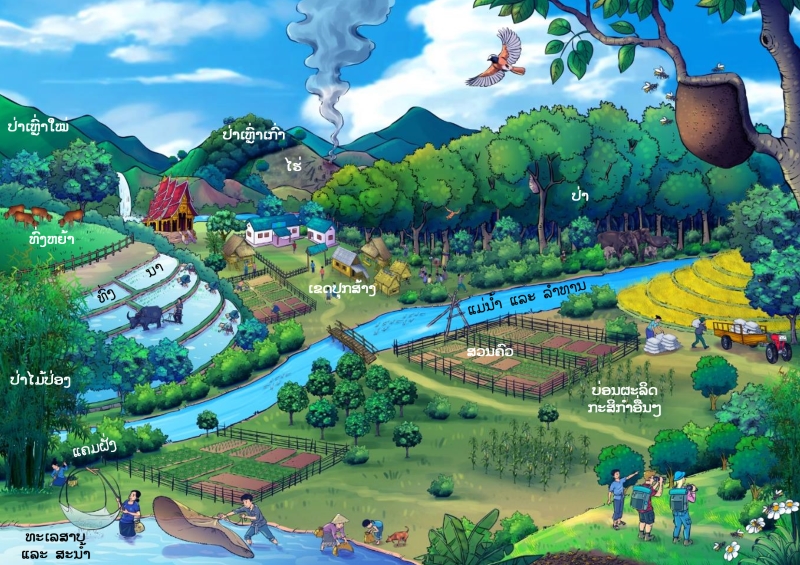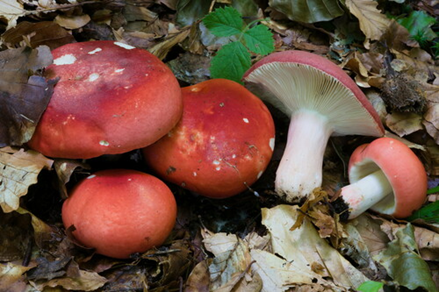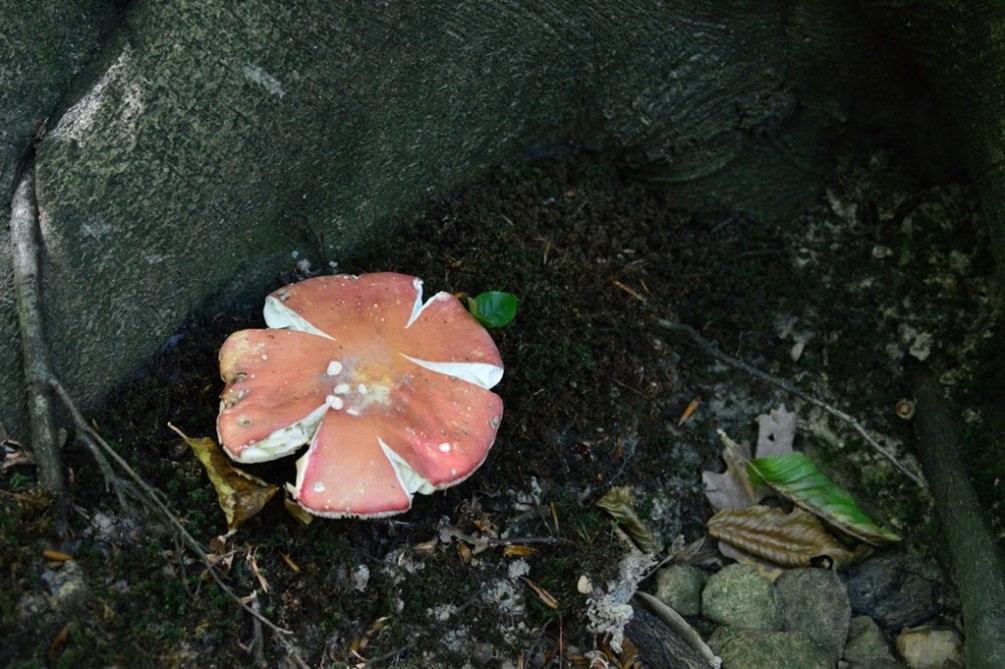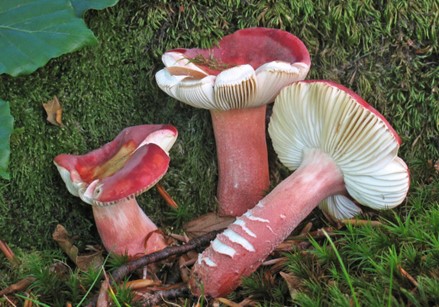ເລກລຳດັບທີ: 127
ລະດັບການຮວບຮວມຂໍ້ມູນ: ຂໍ້ມູນລະອຽດ
ປັບປູງຄັ້ງລ່າສຸດ: N/A
ເຫັດກໍ່ແດງ
Rosy Russula
Russula rosea Pers.
ເຊື້ອເຫັດ
ເຊື້ອຣາທີ່ເກີດຕາມດິນ
×
ຊື່ທ້ອງຖີ່ນ:
ເຫັດແດງ ( Rosy Brittlegill)
ຊື່ພ້ອງ
:
Agaricus lacteus Pers.
Agaricus linnaei Fr.
Russula cypriani Gillet
Russula incarnata Morgan
Russula incarnata Quél.
Russula incarnata var. livida Bres.
Russula lactea (Pers.) Bres.
Russula lactea Fr.
Russula lactea var. australis Cleland
Russula lactea var. incarnata (Quél.) Cooke
Russula lactea var. livida (Bres.) Cooke
Russula lepida Fr.
Russula lepida f. ochroleucoides
Russula lepida var. alba Rea
Russula lepida var. britannica Reumaux & Frund
Russula lepida var. cypriani (Gillet) Reumaux & Frund
Russula lepida var. giacomoi Reumaux & Frund
Russula lepida var. lactea (Fr.) F.H.Møller & Jul.Schäff.
Russula lepida var. lactea (Pers.) Corbelli
Russula lepida var. linnaei (Fr.) Reumaux & Frund, 2011
Russula lepida var. microspora J.Aug.Schmitt
Russula lepida var. salmonea Zvára
Russula lepida var. sapinea Zvára
Russula lepida var. speciosa Zvára
Russula linnaei (Fr.) Fr.
Russula morganii Sacc.
Russula rosea f. pulposa Romagn.
Russula sanguinea var. linnaei (Fr.) Quél.
Russulina linnaei (Fr.) F.Kauffman
Agaricus linnaei Fr.
Russula cypriani Gillet
Russula incarnata Morgan
Russula incarnata Quél.
Russula incarnata var. livida Bres.
Russula lactea (Pers.) Bres.
Russula lactea Fr.
Russula lactea var. australis Cleland
Russula lactea var. incarnata (Quél.) Cooke
Russula lactea var. livida (Bres.) Cooke
Russula lepida Fr.
Russula lepida f. ochroleucoides
Russula lepida var. alba Rea
Russula lepida var. britannica Reumaux & Frund
Russula lepida var. cypriani (Gillet) Reumaux & Frund
Russula lepida var. giacomoi Reumaux & Frund
Russula lepida var. lactea (Fr.) F.H.Møller & Jul.Schäff.
Russula lepida var. lactea (Pers.) Corbelli
Russula lepida var. linnaei (Fr.) Reumaux & Frund, 2011
Russula lepida var. microspora J.Aug.Schmitt
Russula lepida var. salmonea Zvára
Russula lepida var. sapinea Zvára
Russula lepida var. speciosa Zvára
Russula linnaei (Fr.) Fr.
Russula morganii Sacc.
Russula rosea f. pulposa Romagn.
Russula sanguinea var. linnaei (Fr.) Quél.
Russulina linnaei (Fr.) F.Kauffman
ຊື່ສະກຸນ:
Russulaceae
ຊະນິດໃກ້ຄຽງ:
ເຫັດນ້ຳແປ້ງ/ White Russula
ເຫັດແດງໃຫຍ່/ Bloody Brittlegill
ເຫັດຖ່ານ/ Charcoal Russula
ເຫັດໄຄ/ Green-cracking Russula
ເຫັດໜ້າງົວ / Stinking Russula
ເຫັດແດງໃຫຍ່/ Bloody Brittlegill
ເຫັດຖ່ານ/ Charcoal Russula
ເຫັດໄຄ/ Green-cracking Russula
ເຫັດໜ້າງົວ / Stinking Russula
ບັນຍາຍລັກສະນະທາງພືດສາດ:
ເຫັດກໍແດງມີຂະໜາດຂ້ອນຂ້າງໃຫຍ່ ແລະ ມີເນື້ອ ທີ່ເຮັດໃຫ້ມີລັກສະນະຂ້ອນຂ້າງໃຫຍ່.
ກ້ານເຫັດມີສີຈືດ ແລະ ຮຽວລົງເລັກນ້ອຍບໍລິເວນໂຄນຕົ້ນ ມີສີສົມພູເຂັ້ມ ຫຼື ສີສົມພູອ່ອນບໍລິເວນປາຍກ້ານ ຫຼື ສ່ວນອື່ນໆ ແລະ ມີເນື້ອແໜ້ນ.
ໝວກເຫັດສາມາດຍາວໄດ້ຮອດ 100 ມມ. ແລະ ມີສີແດງອົມມ່ວງ ໂດຍມີສ່ວນແກນກາງທີ່ເລິກກ່ວາ ມີລັກສະນະເປັນຮອຍວັກ ແລະ ມີຮອຍແຕກເປັນຕາຂ່າຍ ໂດຍຈະມີສີສົມພູຢູ່ດ້ານລຸ່ມເມື່ອລອກອອກ, ຂອບໝວກເຫັດເປັນຮ່ອງເລັກນ້ອຍ ເຊິ່ງໝາຍຄວາມວ່າມີຮ່ອງຕື້ນໆ.
ເງືອກເຫັດມີສີຄີມອ່ອນໆ ແລະ ມີສີແດງບໍລິເວນໃກ້ກ້ານ ແລະ ຂອບ ໃນຂະນະທີ່ບໍລິເວນອື່ນຈະເປັນສີຂາວ.
ເນື້ອເຫັດຊະນິດນີ້ນີ້ຈະອ່ອນ, ມີສີເທົາເລັກນ້ອຍ ແລະ ມີຂຸດສີເທົາເຂັ້ມຂື້ນບໍລິເວນໂຄນກ້ານ ເຊິ່ງອາດຈະບອກເຖິ່ງອາຍຸ ຫຼື ຮອຍຊ້ຳໄດ້.
ສະປໍທີ່ສະສົມຈະເປັນສີຂາວ ເຊິ່ງເປັນສີຂອງສະປໍເມື່ອຖືກປ່ອຍອອກມາ.
ແຫຼ່ງທີ່ມາ: [1]
ກ້ານເຫັດມີສີຈືດ ແລະ ຮຽວລົງເລັກນ້ອຍບໍລິເວນໂຄນຕົ້ນ ມີສີສົມພູເຂັ້ມ ຫຼື ສີສົມພູອ່ອນບໍລິເວນປາຍກ້ານ ຫຼື ສ່ວນອື່ນໆ ແລະ ມີເນື້ອແໜ້ນ.
ໝວກເຫັດສາມາດຍາວໄດ້ຮອດ 100 ມມ. ແລະ ມີສີແດງອົມມ່ວງ ໂດຍມີສ່ວນແກນກາງທີ່ເລິກກ່ວາ ມີລັກສະນະເປັນຮອຍວັກ ແລະ ມີຮອຍແຕກເປັນຕາຂ່າຍ ໂດຍຈະມີສີສົມພູຢູ່ດ້ານລຸ່ມເມື່ອລອກອອກ, ຂອບໝວກເຫັດເປັນຮ່ອງເລັກນ້ອຍ ເຊິ່ງໝາຍຄວາມວ່າມີຮ່ອງຕື້ນໆ.
ເງືອກເຫັດມີສີຄີມອ່ອນໆ ແລະ ມີສີແດງບໍລິເວນໃກ້ກ້ານ ແລະ ຂອບ ໃນຂະນະທີ່ບໍລິເວນອື່ນຈະເປັນສີຂາວ.
ເນື້ອເຫັດຊະນິດນີ້ນີ້ຈະອ່ອນ, ມີສີເທົາເລັກນ້ອຍ ແລະ ມີຂຸດສີເທົາເຂັ້ມຂື້ນບໍລິເວນໂຄນກ້ານ ເຊິ່ງອາດຈະບອກເຖິ່ງອາຍຸ ຫຼື ຮອຍຊ້ຳໄດ້.
ສະປໍທີ່ສະສົມຈະເປັນສີຂາວ ເຊິ່ງເປັນສີຂອງສະປໍເມື່ອຖືກປ່ອຍອອກມາ.
ແຫຼ່ງທີ່ມາ: [1]
ນິເວດວິທະຍາ
ເຂດກະຈາຍພັນທົ່ວໂລກ:
Native to Andorra, Armenia, Austria, Azerbaijan, Belgium, Bosnia and Herzegovina, Canada, China, Croatia, Czechia, Denmark, Finland, France, Georgia, Germany, Gibraltar, Holy See, Hong Kong, Hungary, India, Ireland, Isle of Man, Israel, Italy, Japan, Jordan, Korea, Liechtenstein, Luxembourg, Macao, Malta, Mexico, Monaco; Montenegro, Nepal, Netherlands, North Macedonia, Norway, Poland, Portugal, Romania, Russian Federation, San Marino, Serbia, Slovakia, Slovenia, Spain, Sri Lanka, Sweden, Switzerland, Thailand, Lao, Türkiye, United Kingdom, and United States. [4]
Global distribution of the Russula rosea between 2003 to 2024. Source: [2]
ເຂດກະຈາຍພັນທົ່ວໂລກຂອງເຫັດກໍ່ແດງໃນຊ່ວງປີ 2004 ຫາ 2024. ແຫຼ່ງທີ່ມາ: [2].
Global distribution of the Russula rosea between 2003 to 2024. Source: [2]
ເຂດກະຈາຍພັນທົ່ວໂລກຂອງເຫັດກໍ່ແດງໃນຊ່ວງປີ 2004 ຫາ 2024. ແຫຼ່ງທີ່ມາ: [2].
ເຂດກະຈາຍພັນໃນລາວ
:
ເຂດພູສູງພາກເໜືອຂອງລາວ
ລຽບແມ່ນ້ຳຂອງພາກເໜືອ
ເຂດພູສູງສາຍພູຫຼວງ ແລະ ເຂດພູພຽງແຂວງຊຽງຂວາງ
ລຽບແມ່ນ້ຳຂອງພາກເໜືອ
ເຂດພູສູງສາຍພູຫຼວງ ແລະ ເຂດພູພຽງແຂວງຊຽງຂວາງ

ເຂດກະຈາຍພັນຕາມພູມສັນຖານ
:
ປ່າແປກ
ປ່າແປກປະສົມປ່າໃບກ້ວາງ
ປ່າແປກປະສົມປ່າໃບກ້ວາງ

ສະເພາະຖິ່ນໃນລາວ:
ພື້ນເມືອງ
ຮຸກຮານ
:
ບໍ່ຮຸກຮານ
ສະຖານະພາບການອະນູຮັກ IUCN
:
ມີຄວາມສ່ຽງໜ້ອຍສຸດ
ສະຖານະພາບການອະນຸຮັກແຫ່ງຊາດລາວ
:
ບັນຊີທີ່ III: ຊະນິດພັນປະເພດທົ່ວໄປ
ການນຳໃຊ້
ປະເພດການນຳໃຊ້:
ອາຫານ
ພືດເປັນຢາ
ພືດເປັນຢາ
ບັນຍາຍການນຳໃຊ້:
ອາຫານ: ເຫັດແດງເປັນອາຫານປ່າທີ່ກິນໄດ້ ມີຄຸນຄ່າທາງດ້ານໂພຊະນາການສູງ ແລະ ນິຍົມນຳມາປຸ່ງແຕ່ງ ແລະ ໃຊ້ເປັນສ່ວນປະສົມໃນອາຫານທ້ອງຖິ່ນ [7]. ກິນໄດ້ ແລະ ເກັບກ່ຽວເປັນສິນຄ້າ. [1]
ສະມຸນໄພ: ຖືກນຳມາໃຊ້ເປັນຢາພື້ນເມືອງມາເປັເວລາດົນນານ ເນື່ອງຈາກຄຸນສົມບັດທາງສະມຸນໄພຂອງເຫັດຊະນິດ ເຊິ່ງອຸດົມໄປດ້ວຍສານທາງຊີວະພາບ ທີ່ມັກສັກກະຍາພາບໃນການຕ້ານອານຸມູນອິດສະຫຼະ ເຊິ່ງອາດຊ່ວຍຫຼຸດຄວາມສ່ຽງຂອງ,ຣກມະເຮັງ, ໂຣກຫົວໃຈ ແລະ ຫຼອດເລືອດ. ນອກຈາກນ້ເຫັດກໍ່ແດງແດງຍັງໄດ້ຮັບການພິສູດແລ້ວວ່າສາມາດເສີມສ້າງລະບົບພູຄຸ້ມກັນ, ເພີ່ມຄວາມສາມາດຂອງຮ່າງກາຍ ໃນການປ້ອງກັນການຕິດເຊື້ອ ແລະ ມີຄຸນສົມບັດຕ້ານແບັກທິເຣຍ ນອກຈາກນີ້ຍັງອາດຊ່ວຍຄວບຄຸມພະຍາດເບົາຫວານ, ປ້ອງກັນຕັບຈາກສານພິດ ແລະ ພະຍາດຕ່າງໆໄດ້ອີກດ້ວຍ. [7]
ສະມຸນໄພ: ຖືກນຳມາໃຊ້ເປັນຢາພື້ນເມືອງມາເປັເວລາດົນນານ ເນື່ອງຈາກຄຸນສົມບັດທາງສະມຸນໄພຂອງເຫັດຊະນິດ ເຊິ່ງອຸດົມໄປດ້ວຍສານທາງຊີວະພາບ ທີ່ມັກສັກກະຍາພາບໃນການຕ້ານອານຸມູນອິດສະຫຼະ ເຊິ່ງອາດຊ່ວຍຫຼຸດຄວາມສ່ຽງຂອງ,ຣກມະເຮັງ, ໂຣກຫົວໃຈ ແລະ ຫຼອດເລືອດ. ນອກຈາກນ້ເຫັດກໍ່ແດງແດງຍັງໄດ້ຮັບການພິສູດແລ້ວວ່າສາມາດເສີມສ້າງລະບົບພູຄຸ້ມກັນ, ເພີ່ມຄວາມສາມາດຂອງຮ່າງກາຍ ໃນການປ້ອງກັນການຕິດເຊື້ອ ແລະ ມີຄຸນສົມບັດຕ້ານແບັກທິເຣຍ ນອກຈາກນີ້ຍັງອາດຊ່ວຍຄວບຄຸມພະຍາດເບົາຫວານ, ປ້ອງກັນຕັບຈາກສານພິດ ແລະ ພະຍາດຕ່າງໆໄດ້ອີກດ້ວຍ. [7]
ການປູກ ການລ້ຽງ:
ຊະນິດທຳມະຊາດ
ລະດູການເກັບກູ້:
ສິງຫາ
ກັນຍາ
ຕຸລາ
ກັນຍາ
ຕຸລາ
ການຕະຫຼາດ ແລະ ຕ່ອງໂສ້ມູນຄ່າ:
ເຫັດກໍ່ແດງມີຄວາມສຳຄັນທາງດ້ານເສດຖະກິດ ເນື່ອງຈາດຄວາມຕ້ອງການໃນຕະຫຼາດສູງ ໂດຍສເພາະເຫັດຕາກແຫ້ງ ຫຼື ອົບແຫ້ງ ທີ່ຂາຍສົ່ງໄປຍັງປະເທດຈີນ. ນອກຈາກນີ້ເຫັດກໍ່ແດງ ຍັງຈຳນ່າຍໃນຕະຫຼາດທ້ອງຖິ່ນ ແລະ ແຄມທາງ ເພີ່ມໂອກາດໃນການສ້າງລາຍໄດ້ ໂດຍສະເພາະເຂດຊົນນະບົດ ແລະ ຊົນເຜົາພື້ນເມືອງ. [7]
ການຄຸ້ມຄອງຈັດການ
ສະພາບໂດຍລວມ: ເຫັດຊະນິດນີ້ມີຢູ່ 2 ສາຍພັນ ຄື: Russula lepida var. alba Quél. And Russula lepida var. lepida. [2]
ການເກັບກູ້ແບບຍືຍຍົງ:
ແຜ່ນການຈັດການປ່າເຫັດກໍ່ແດງ ໄດ້ຮັບການອອກແບບມາເພື່ອສອດຄ່ອງກັນລະຫວ່າງຄວາມຕ້ອງການຂອງປະຊາຊົນ ແລະ ສິ່ງແວດລ້ອມ ໂດຍແບ່ງປ່າອອກເປັນ 3 ປະເພດ ໄດ້ແກ່: ປ່າຄຸ້ມຄອງ, ປ່າອານຸລັກ ແລະ ປ່າຜະລິດ. ໂດຍປ່າຄຸ້ມຄອງ ແລະ ປ່າອານຸລັກແບ່ງອອກເປັນ 2 ເຂດ ຄື ພື້ນທີ່ຄຸ້ມຄອງທັງໝົດ (ຫວງຫ້າມເດັດຂາດ) ເຊິ່ງເປັນພື້ນທີ່ທີ່ອ່ອນໄຫວທີ່ສຸດ (ພື້ນທີ່ສຳຄັນ) ແລະ ພື້ນທີ່ທີ່ຄວບຄຸມ ຫຼື ຈຳກັດການໃຊ້ ເຊິ່ງມີຄວາມສ່ຽງໜ້ອຍກ່ວາ ແຕ່ຍັງຄົງຕ້ອງມີການຈັດການ ຢ່າງລະມັດລະວັງ ເມື່ອທຽບກັບພື້ນີ່ນອກປ່າສະຫງວນ ແລະ ປ່າສະງວນ. [7]
ກົດໝາຍ ແລະ ນະໂຍບາຍ:
ອີງຕາມການກຳນົດ ໃນມາດ ຕາ 39 ຂອງກົດໝາຍວ່າດ້ວຍປ່າໄມ້ເລກທີ່ 64/ສພຊ ລົງວັນທີ່ 13 ມິຖຸນາ 2019 (ກົມປ່າໄມ້, 2019). ດັງນັ້ນຈຶ່ງໄດ້ມີການອອກຂໍ້ກຳນົດໃນການຄຸ້ມຄອງເຄື່ອງປ່າຂອງດົງ (ເຫັດກໍ່ແດງ) ດັງນີ້:
• ຫ້າມປະຊາຊົນມີການເກັບເຫັດປ່າຕາມທຳມະຊາດແບບດັບສູນ
• ຫ້າມຕັດໄມ້ທຳລາຍປ່າ ເຊັ່ນ: ປ່າໄມ້ກໍ່ ຫຼື ປ່າໄມ້ທີ່ໃຫ້ຄວາມຊຸ່ມ ແລະ ເປັນເຂດ ຜະລິດເຊື້ອເຫັດຕາມທຳມະຊາດ.
• ຫ້າມບໍ່ໃຫ້ປະຊາຊົນ ຫຼື ຜູ້ເກັບກູ້ເຫັດນຳໃຊ້ອຸປະກອນ ເຊັ່ນ: ສຽມ, ຈົກ ແລະ ພ້າ ໃນການຂຸດພວນດິນ ໃນການເກັບກູ້ເຫັດກໍ່ແດງ ຫຼື ເຫັດປ່າຊະນິດອື່ນ ທີ່ເກີດຕາມທຳມະຊາດເດັດຂາດ ເພາະຈະເປັນການທຳລາຍເຊື້ອເຫັດທີ່ເກີດຕາມທຳມະຊາດ ແລະ ອາດນຳໄປສູ່ການຫຼຸດລົງຂອງເຫັດປ່າ.
• ຫ້າມຕັດໄມ້ທຳລາຍປ່າຕາມທຳມະຊາດເພື່ອກະສິກຳ ແລະ ລ້ຽງສັດ ໂດຍບໍ່ໄດ້ຮັບຄຳອານຸຍາດຈາກພາກສ່ວນທີ່ກ່ຽວຂ້ອງ.
• ຫ້າມຈູດປ່າເພື່ອລ່າສັດ ແລະ ຫ້າມຈູດປ່າໃນພື້ນທີ່ຄຸ້ມຄອງເຫັດ ແລະ ເຄື່ອງປ່າຂອງດົງຊະນິດອື່ນ
• ຫ້າມຜູ້ທີ່ເປັນຊະມາຊິກ ຫຼື ບໍ່ເປັນຊະມາຊິກກຸ່ມ ເກັບກູ້ເຫັດຕາມທຳມະຊາດກ່ອນໄດ້ຮັບອານຸຍາດຈາກຄະນະກຸ່ມ ຫຼື ກຳນົດເກັບກູ້ຢ່າງເປັນທາງການ.
• ຫ້າມພໍ່ຄ້າ ຫຼື ບຸກຄົນທີ່ບໍ່ມີໃບອານຸຍາດເກັບຊື້ເຫັດເຂົ້າມາເກັບຊື້ເຫັດເດັດຂາດ. [7]
ມາດຕະການຕໍ່ຜູ້ທີ່ລະເມີດສິດ:
ຫາໃຜຫາກຜ່າຝືນກົດລະບຽບທາງຄະນະກຸ່ມຈະເອີ້ນມາຕັກເຕືອນໃນຄັ້ງທຳອິດ ຫາກຍັງເຮັດຜິດຊໍ້າຄັ້ງທີ່ສອງ ຄະນະບ້ານຈະເອ້ນມາຕັກເຕືອນ ແລະ ຂຽນໃບປະຕິຍານຕົນ, ແຕ່ຖ້າມີຄັ້ງທີ່ສາມ ຈະໄດ້ປັບໄໝຕາມມູນຄ່າການເກັບຊື້ເຫັດຕົວຈິງ. [7]
ການເກັບກູ້ແບບຍືຍຍົງ:
ແຜ່ນການຈັດການປ່າເຫັດກໍ່ແດງ ໄດ້ຮັບການອອກແບບມາເພື່ອສອດຄ່ອງກັນລະຫວ່າງຄວາມຕ້ອງການຂອງປະຊາຊົນ ແລະ ສິ່ງແວດລ້ອມ ໂດຍແບ່ງປ່າອອກເປັນ 3 ປະເພດ ໄດ້ແກ່: ປ່າຄຸ້ມຄອງ, ປ່າອານຸລັກ ແລະ ປ່າຜະລິດ. ໂດຍປ່າຄຸ້ມຄອງ ແລະ ປ່າອານຸລັກແບ່ງອອກເປັນ 2 ເຂດ ຄື ພື້ນທີ່ຄຸ້ມຄອງທັງໝົດ (ຫວງຫ້າມເດັດຂາດ) ເຊິ່ງເປັນພື້ນທີ່ທີ່ອ່ອນໄຫວທີ່ສຸດ (ພື້ນທີ່ສຳຄັນ) ແລະ ພື້ນທີ່ທີ່ຄວບຄຸມ ຫຼື ຈຳກັດການໃຊ້ ເຊິ່ງມີຄວາມສ່ຽງໜ້ອຍກ່ວາ ແຕ່ຍັງຄົງຕ້ອງມີການຈັດການ ຢ່າງລະມັດລະວັງ ເມື່ອທຽບກັບພື້ນີ່ນອກປ່າສະຫງວນ ແລະ ປ່າສະງວນ. [7]
ກົດໝາຍ ແລະ ນະໂຍບາຍ:
ອີງຕາມການກຳນົດ ໃນມາດ ຕາ 39 ຂອງກົດໝາຍວ່າດ້ວຍປ່າໄມ້ເລກທີ່ 64/ສພຊ ລົງວັນທີ່ 13 ມິຖຸນາ 2019 (ກົມປ່າໄມ້, 2019). ດັງນັ້ນຈຶ່ງໄດ້ມີການອອກຂໍ້ກຳນົດໃນການຄຸ້ມຄອງເຄື່ອງປ່າຂອງດົງ (ເຫັດກໍ່ແດງ) ດັງນີ້:
• ຫ້າມປະຊາຊົນມີການເກັບເຫັດປ່າຕາມທຳມະຊາດແບບດັບສູນ
• ຫ້າມຕັດໄມ້ທຳລາຍປ່າ ເຊັ່ນ: ປ່າໄມ້ກໍ່ ຫຼື ປ່າໄມ້ທີ່ໃຫ້ຄວາມຊຸ່ມ ແລະ ເປັນເຂດ ຜະລິດເຊື້ອເຫັດຕາມທຳມະຊາດ.
• ຫ້າມບໍ່ໃຫ້ປະຊາຊົນ ຫຼື ຜູ້ເກັບກູ້ເຫັດນຳໃຊ້ອຸປະກອນ ເຊັ່ນ: ສຽມ, ຈົກ ແລະ ພ້າ ໃນການຂຸດພວນດິນ ໃນການເກັບກູ້ເຫັດກໍ່ແດງ ຫຼື ເຫັດປ່າຊະນິດອື່ນ ທີ່ເກີດຕາມທຳມະຊາດເດັດຂາດ ເພາະຈະເປັນການທຳລາຍເຊື້ອເຫັດທີ່ເກີດຕາມທຳມະຊາດ ແລະ ອາດນຳໄປສູ່ການຫຼຸດລົງຂອງເຫັດປ່າ.
• ຫ້າມຕັດໄມ້ທຳລາຍປ່າຕາມທຳມະຊາດເພື່ອກະສິກຳ ແລະ ລ້ຽງສັດ ໂດຍບໍ່ໄດ້ຮັບຄຳອານຸຍາດຈາກພາກສ່ວນທີ່ກ່ຽວຂ້ອງ.
• ຫ້າມຈູດປ່າເພື່ອລ່າສັດ ແລະ ຫ້າມຈູດປ່າໃນພື້ນທີ່ຄຸ້ມຄອງເຫັດ ແລະ ເຄື່ອງປ່າຂອງດົງຊະນິດອື່ນ
• ຫ້າມຜູ້ທີ່ເປັນຊະມາຊິກ ຫຼື ບໍ່ເປັນຊະມາຊິກກຸ່ມ ເກັບກູ້ເຫັດຕາມທຳມະຊາດກ່ອນໄດ້ຮັບອານຸຍາດຈາກຄະນະກຸ່ມ ຫຼື ກຳນົດເກັບກູ້ຢ່າງເປັນທາງການ.
• ຫ້າມພໍ່ຄ້າ ຫຼື ບຸກຄົນທີ່ບໍ່ມີໃບອານຸຍາດເກັບຊື້ເຫັດເຂົ້າມາເກັບຊື້ເຫັດເດັດຂາດ. [7]
ມາດຕະການຕໍ່ຜູ້ທີ່ລະເມີດສິດ:
ຫາໃຜຫາກຜ່າຝືນກົດລະບຽບທາງຄະນະກຸ່ມຈະເອີ້ນມາຕັກເຕືອນໃນຄັ້ງທຳອິດ ຫາກຍັງເຮັດຜິດຊໍ້າຄັ້ງທີ່ສອງ ຄະນະບ້ານຈະເອ້ນມາຕັກເຕືອນ ແລະ ຂຽນໃບປະຕິຍານຕົນ, ແຕ່ຖ້າມີຄັ້ງທີ່ສາມ ຈະໄດ້ປັບໄໝຕາມມູນຄ່າການເກັບຊື້ເຫັດຕົວຈິງ. [7]
ໂພຊະນາການ
ຄຸນຄ່າທາງໂພຊະນາການ:
ແຫຼ່ງໂປຣຕີນທີ່ສຳຄັນ
ບັນຍາຍຄຸນຄ່າທາງໂພຊະນາການ:
ເຫັດນີ້ ມີທາດໂປຼຕີນ, ເປັນປະໂຫຍດສໍາລັບອາຫານທີ່ສົມດູນ. ປະລິມານຄາໂບໄຮເດດສູງ ເຮັດໃຫ້ມັນເປັນແຫຼ່ງພະລັງງານທີ່ມີສຸຂະພາບດີຕໍ່ຄົນເຮົາ. ໄຂມັນຕ່ໍາປະກອບສ່ວນເຂົ້າໃນໂປຼໄຟລ໌ທີ່ມີແຄລໍລີ່ຕໍ່າ [6]. ເຫັດກໍ່ແດງເປັນເຫັດທີ່ມີຄຸນຄ່າທາງດ້ານໂພຊະນາການສູງ ແລະ ເປັນແຫຼ່ງໂປຣຕີນທີ່ສຳຄັນ, ນອກຈາກນີ້ຍັງເປັນແຫຼ່ງທີ່ອຸດົມໄປດ້ວຍເສັ້ນໄຍອາຫານ ແລະ ວິຕາມິນ ເຊ່ນ ວິຕາມິນຊີ, ວິຕາມິນ B2, B3, B5 ແລະ ແຄລໂລທີນ, ນອກຈາກນີ້ຍັງມີ ແຮ່ທາດທີ່ຈຳເປັນເຊັ່ນ: ໂພແທັກຊ້ຽມ, ຟອສຟໍຣັສ ແລະ ທ້ອງແດງມ ໃນຄະນະທີ່ມີແຄລໍຣີ້ ແລະ ໄຂມັນຕ່ຳ. [7]
| ສານອາຫານ | /100g | ໝາຍເຫດ |
|---|---|---|
| ໂປຣຕີນ | 12.2 | N/A |
| ຄາໂບໄຮເດຣດ | 82.03 | N/A |
| ໄຂມັນ | N/A | N/A |
| ວິຕາມິນ | 0.84 | N/A |
| ແຮ່ທາດ | N/A | N/A |
| ເສັ້ນໄຍ | N/A | N/A |
ອ້າງອິງ
ເຄດິດຮູບພາບ:
Rosy russula in nature. [1] Observation.org [Online]. Uploaded on 02 October 2018 by: Benjamín O'Ryan Correa. Available: https://observation.org/photos/81024621/. [Accessed: 13 October 2024]
Group of Rosy russula of different sizes. [2] iNaturalist [Online]. Uploaded on 02 August 2023 by: marcofloriani. Available: www.inaturalist.org/photos/307815870. [Accessed: 13 October 2024]
Rosy russula up close. [3] iNaturalist [Online]. Uploaded on 17 December 2022 by: nevo_. Available: https://www.inaturalist.org/photos/248092460. [Accessed: 13 October 2024]
Group of Rosy russula of different sizes. [2] iNaturalist [Online]. Uploaded on 02 August 2023 by: marcofloriani. Available: www.inaturalist.org/photos/307815870. [Accessed: 13 October 2024]
Rosy russula up close. [3] iNaturalist [Online]. Uploaded on 17 December 2022 by: nevo_. Available: https://www.inaturalist.org/photos/248092460. [Accessed: 13 October 2024]
ອ້າງອິງ:
[1] T. Laessoe and et al., "An Introduction to the Edible, Poisonous and Medical Fungi of Northern Laos," Agro-Biodiversity Project, 2018.
[2] Global Biodiversity Information Facility [Online]. “Russula rosea”. Available: https://www.gbif.org/species/2551240 [Accessed: 13 October 2024]
[3] First-Nature, “Russula rosea,” [Online]. Available: https://www.first-nature.com/fungi/russula-rosea.php [Accessed: 01 August 2024]
[4] "Amanita hemibapha," IUCN Red List of Threatened Species, 2024. [Online]. Available: https://www.iucnredlist.org/species/260390792/260390794#habitat-ecology. [Accessed: April 22, 2025].
[5] "Poster: Mushroom of Chomphet," 2024. [Online]. Available: file:///C:/Users/duang/Downloads/Poster_1Mushroomofchomphet.pdf. [Accessed: Apr. 22, 2025].
[6] M. Kostic et al., "Antioxidant Extracts of Three Russula Genus Species Express Diverse Biological Activity," Molecules, pp. 1-14, 2020.
[7]. ບັນຊາ ທຳມະວົງ. 2025. ຄູມືການຄຸ້ມຄອງເຄື່ອງປ່າຂອງດົງ (ເຫັດແດງ)ໃ ສະຖາບັນຄົ້ນຄວ້າກະຊິກ, ປ່າໄມ້ ແລະ ພັດທະນາຊົນນະບົດ, ສູນຄົ້ນຄວ້າປ່າໄມ້, ໂຄງການກະຊິກຳເພື່ອໂພຊະນາການ ໄລຍະ II. ໜ້າ 1-27.
[2] Global Biodiversity Information Facility [Online]. “Russula rosea”. Available: https://www.gbif.org/species/2551240 [Accessed: 13 October 2024]
[3] First-Nature, “Russula rosea,” [Online]. Available: https://www.first-nature.com/fungi/russula-rosea.php [Accessed: 01 August 2024]
[4] "Amanita hemibapha," IUCN Red List of Threatened Species, 2024. [Online]. Available: https://www.iucnredlist.org/species/260390792/260390794#habitat-ecology. [Accessed: April 22, 2025].
[5] "Poster: Mushroom of Chomphet," 2024. [Online]. Available: file:///C:/Users/duang/Downloads/Poster_1Mushroomofchomphet.pdf. [Accessed: Apr. 22, 2025].
[6] M. Kostic et al., "Antioxidant Extracts of Three Russula Genus Species Express Diverse Biological Activity," Molecules, pp. 1-14, 2020.
[7]. ບັນຊາ ທຳມະວົງ. 2025. ຄູມືການຄຸ້ມຄອງເຄື່ອງປ່າຂອງດົງ (ເຫັດແດງ)ໃ ສະຖາບັນຄົ້ນຄວ້າກະຊິກ, ປ່າໄມ້ ແລະ ພັດທະນາຊົນນະບົດ, ສູນຄົ້ນຄວ້າປ່າໄມ້, ໂຄງການກະຊິກຳເພື່ອໂພຊະນາການ ໄລຍະ II. ໜ້າ 1-27.
ຜູ້ສ້າງ Factsheet:
Keooudone Souvannakhoummane
ຜູ້ກວດສອບ Factsheet:
,


